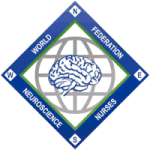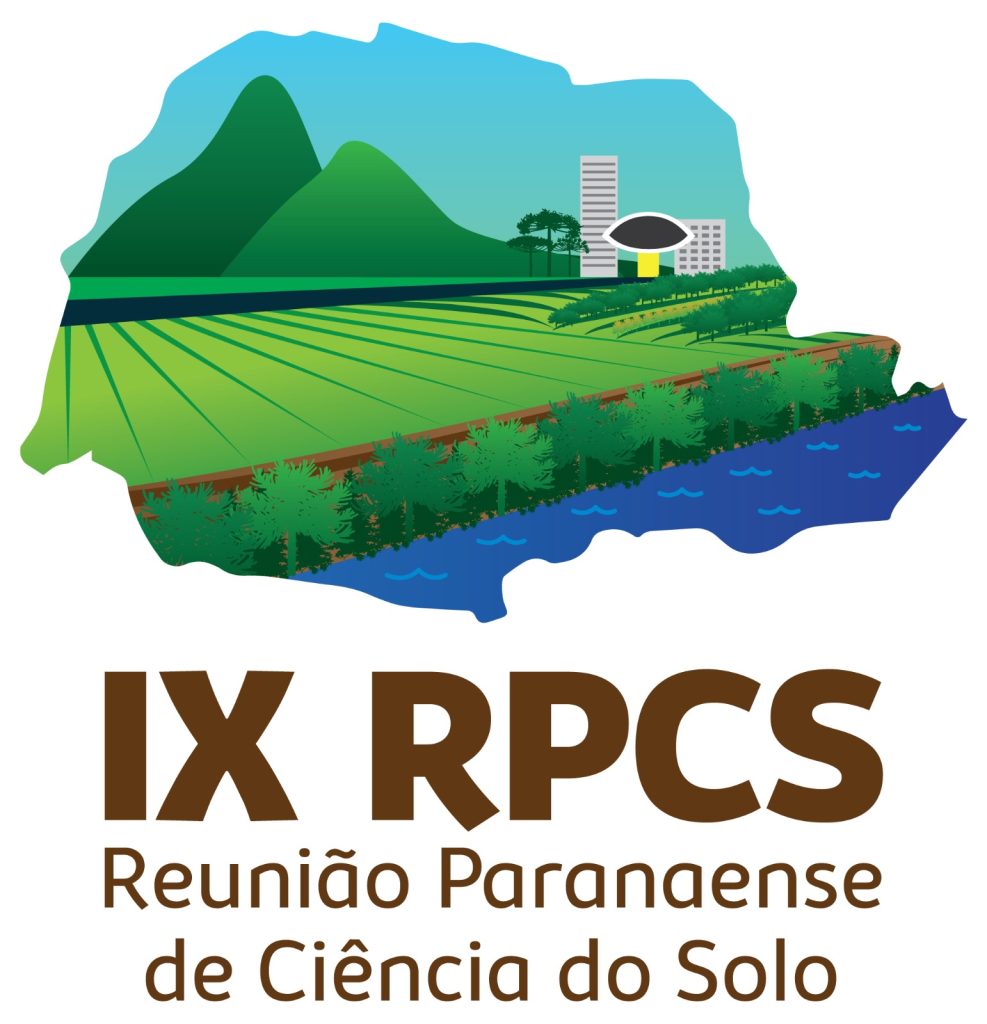
O Núcleo Estadual do Paraná, da SBCS, promove, de 10 a 15 de maio de 2025, no Campus Rebouças da Universidade Federal do Paraná, em Curitiba (PR), a IX Reunião Paranaense de Ciência do Solo (RPCS). O evento terá como tema: “Diversidade, funções e usos do solo: desafios e oportunidades”.A organização está sob responsabilidade da UFPR e das instituições apoiadoras: Embrapa Florestas, IAT-PR, IDR-PR, PUC-PR, SEAB, Sistema FAEP, UTP e UTFPR.A programação prevê palestras, minicursos e excursões técnicas, além da apresentação de trabalhos científicos. As inscrições para participar do evento, minicursos excursões técnicas e submissão de trabalhos científicos estarão abertas até o dia 28 de fevereiro.Mais informações na página do evento.
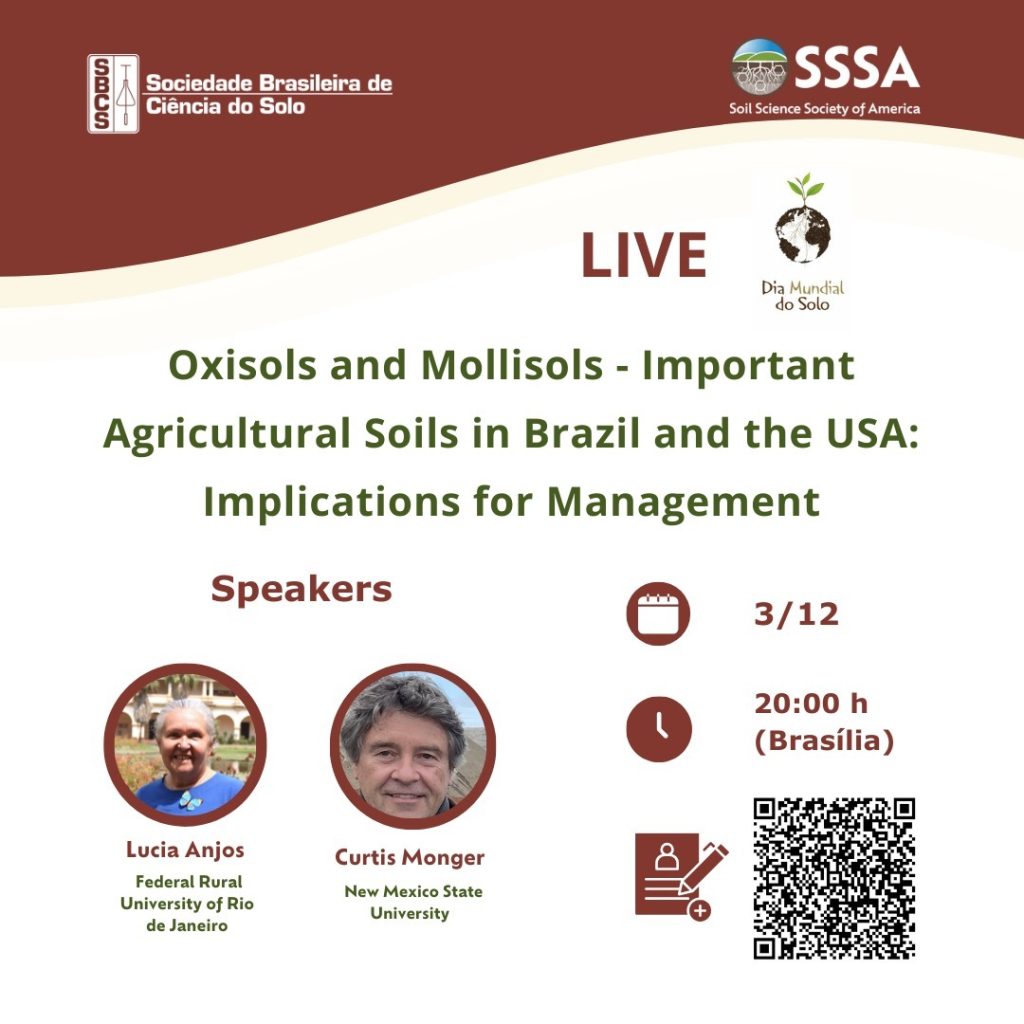
A SBCS celebrou o Dia Mundial do Solo de 2024 realizando uma live com a Sociedade Americana de Ciência do Solo (SSSA).A live, em inglês, pode ser conferida no canal da SSSA no youtube.
Cropping and soil management systems effects on soil organic matter fractions in diversified agricultural fields in the Cerrado
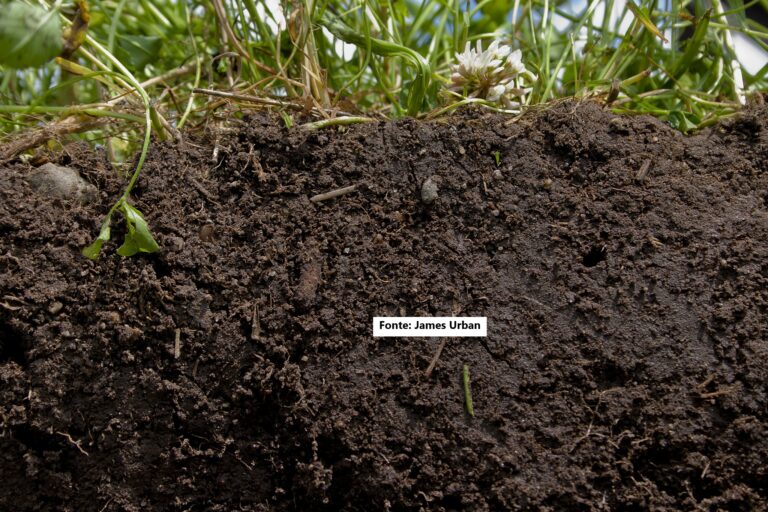
HIGHLIGHTS Vegetation diversity helps maintain soil quality. Soil organic matter compartmentalization can be used to evaluate agricultural systems. Water-floatable light organic matter was effective in evaluating ]soil management. ABSTRACT Soil organic matter (SOM) dynamics can be significantly influenced by various cultivation practices, particularly under environmental and edaphic conditions that enhance and accelerate the transformations of organic materials such as straw, root biomass, and organic fertilizers. This study aimed to evaluate the impact of different cultivation and soil management systems on SOM fractions in agricultural areas of the Cerrado Goiano region. The research was conducted across three areas with diverse production systems: 1) BV area, including soybean monoculture (SM01), integrated crop-livestock-forest (ICLF01), pasture (PA01), and Cerrado vegetation (NV01); 2) ML area, featured soybean-corn monoculture succession (SMS02), agroforestry (AF02), pasture (PA02), and native Cerrado vegetation (NV02); and 3) IF area, comprised soybean-corn succession (SMS03), integrated livestock-forest (ILF03), pasture (PA03), and native Cerrado vegetation (NV03). Disturbed and undisturbed soil samples were collected from two layers: 0.00-0.05 and 0.05-0.10 m. Samples were analyzed for total organic carbon, carbon storage, and SOM physical (granulometric and densimetric) and chemical (fulvic acid, humic acid, and humin) fractionations of soil organic matter (SOM). Additionally, water-floatable light organic matter (LOM), the carbon management index, and its components were determined. Soil organic matter fractions were similarly influenced by the characteristics of cultivation and management systems. However, there were more pronounced differences between systems in the BV area compared to the ML and IF areas. Among the parameters studied, LOM proved to be the most efficient and effective in distinguishing SOM input across different cultivation and soil management systems, particularly in pasture systems.
Cover crops influence the physical hydric quality of a tropical sandy soil under no-tillage cotton cropping
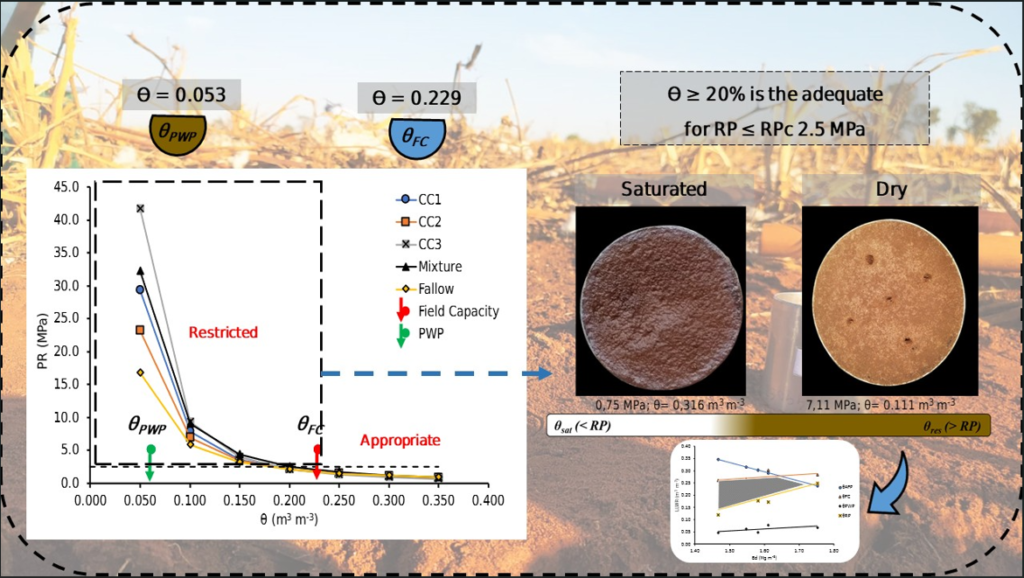
HIGHLIGHTS The results of this study suggest that from the physical properties of the soil analysed, only the PR was influenced by the use of cover crops. At the surface physical limitations due to aeration occurred with Bd > 1.65 Mg m-3, while in the subsurface it occurred with Bd > 1.70 Mg m-3. Soil water contents greater 0.20 m3 m-3 provided soil penetration resistance values lower 2.5 MPa. ABSTRACT Reduced stability and structural resilience expose sandy soils to physical degradation under intensive production systems. This study aimed to evaluate the influence of different cover crops (CC) under no-tillage system (NTS) cotton cropping, grown either individually or in combination, on the soil physical quality (SPQ) of a sandy loam Oxisol (Latossolo) in southeastern Brazil. To quantify the effects of CC on soil physical quality indicators, an experiment in randomized blocks design was implemented with the treatments: CC1: single cultivation of Ruzi grass; CC2: Intercropping of Pearl Millet + Ruzigrass; CC3: Intercropping of Pearl Millet + Velvet bean; CCMixture: Intercropping of Ruzi grass, Pearl Millet and Velvet bean; and Control: maintenance of spontaneous plants. Undisturbed samples were taken from layers 0.00-0.10, 0.10-0.20, 0.20-0.40 and 0.40-0.60 m, in which were determined the soil bulk density (Bd), total porosity (TP), available water (AW), soil penetration resistance (PR) and the least limiting water range (LLWR). According to the multivariate analyses, the CC2 treatment resulted in better SPQ compared to the other treatments. The LLWR, air-filled porosity (θAFP), and AW were responsible for differentiating the CC2 treatment compared to the other treatments evaluated. Regardless of treatments, values of Bd> 1.75 Mg m-3 result in loss of SPQ due to the significant increase in PR and decreases in AW and LLWR. In the CC3 and Control, there was a physical impediment caused by the increase in Bd in the 0.10-0.20 m layer, which could result in the confinement of cotton roots to the surface, making them more susceptible to water stress. Soil PR reached values greater than 2.5 MPa for water contents lower than the θPWP in most treatments. In treatment CC3, for water contents equivalent to the θPWP, the PR did not exceed 6 MPa, while for the other treatments, the PR reached values greater than 10 MPa. Only the PR was influenced using CC. Soil moisture is considered crucial to maintain PR below impeding values, determining the control of the physical quality of this sandy soil.
Drill cuttings from oil exploration improve properties of substrate and growth of Ipê-branco (Tabebuia roseoalba) seedlings
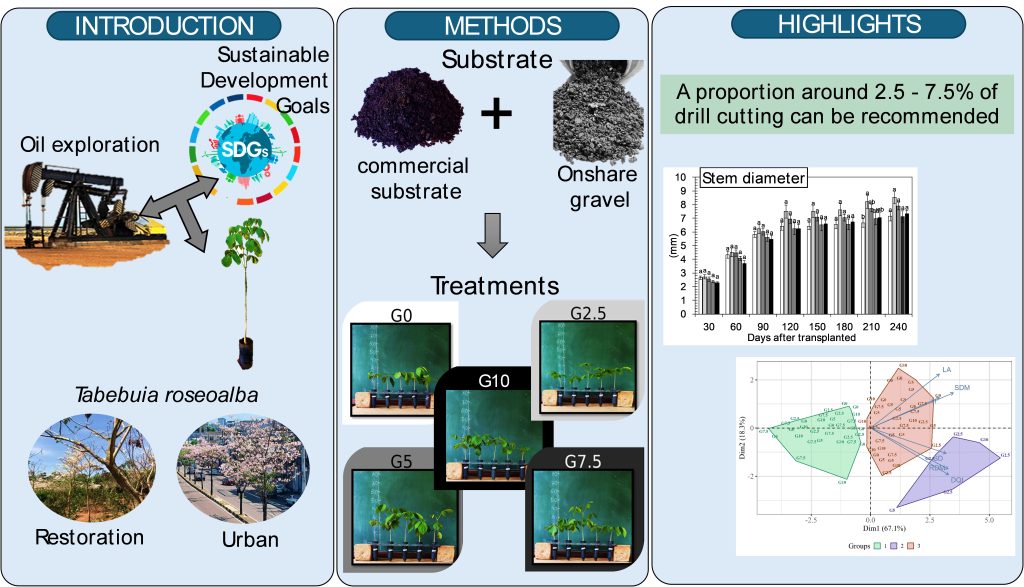
HIGHLIGHTS Substrates with drill cuttings were evaluated for forest seedlings. The addition of drill cuttings led to substrates with higher nutrient concentrations. Heavy metals concentrations in the substrates were below the toxic ranges. The seedlings’ growth and quality were improved by the addition of drill cuttings. A proportion around 2.5 and 7.5% of drill cutting can be recommended. ABSTRACT More information is needed on the potential of using drill cuttings (crushed rocks) from the oil industry in agriculture and forestry. An experiment in forest nursery was carried out to evaluate the influence of substrates formulated from onshore gravel on characteristics of Ipê-branco (Tabebuia roseoalba) seedlings (i.e., growth, quality, and nutrition). We used five gravimetric proportions of gravel from drill cuttings mixed with Pinus-bark – commercial substrate (Mecplant® Florestal 3): control with only commercial substrate and zero gravel (G0), 2.5 % gravel (G2.5), 5 % gravel (G5), 7.5 % gravel (G7.5), and 10 % gravel (G10). In general, high proportion of drill cuttings increases density and decrease current moisture and total porosity of the formulated substrates. The drill cuttings proportions G2.5, G5 and G7.5 significantly contributed to the available water and readily available water in these substrates, with percentage values ranging 23 – 30 % higher than the G10 substrate. Increasing the gravel proportion generally resulted in increased pH levels, P, Na, K and metals (Cu, Fe, Ni, Mn, Cd, Zn, Cr and Pb), except for Ca and Mg nutrients that decreased. Heavy metal contents in all substrates did not exceed the permissible values in legal standards. The G2.5 and G5 substrates increased by 20 % approximately the stem diameter and height of seedlings, and G2.5 proportion also affected the root dry mass and Dickson quality index, with values two times higher than G0 substrate. Multivariate analysis proved suitable as a complementary approach to evaluate the seedling quality. Drilling cuttings addition, in general, increased the accumulation of nutrients and heavy metals of the Ipê-branco seedlings, and G2.5 and G5 substrates provided the greatest accumulation of the nutrients P, Ca, Pb and Zn in the shoot, while G2.5 proportion contributed with higher accumulation of N, Ca, Fe, Cr, Mn and Pb in the root. Adding drill cuttings as a conditioning component of the substrate at 2.5 and 5 % proportions is a viable alternative for using this residue to produce high-quality Tabebuia roseoalba seedling.
Critical levels and fertility classes of soils with high-activity clay in the Brazilian semi-arid region
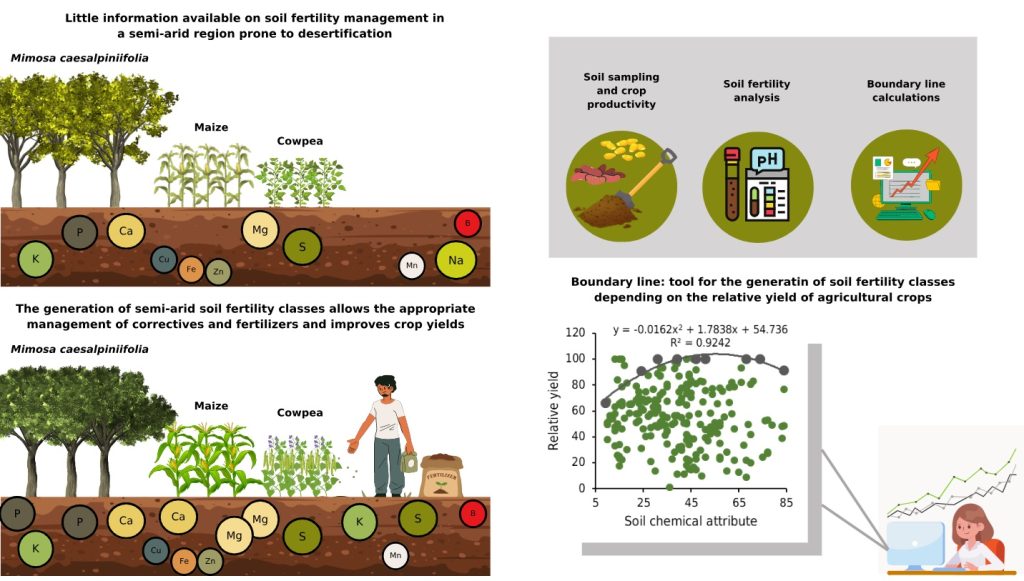
HIGHLIGHTS Boundary line method optimizes nutrient management to obtain high agricultural yields Method based on relative yield generates five classes of interpretation of fertility P, K and Ca show concentrations adequate higher to the reference literature Disregarding the high clay activity in the semi-arid region limits the yield of crops ABSTRACT Soil fertility evaluation is important for adopting conservation management and adequate nutrient supply. The objective of this study was to identify critical levels and soil fertility classes using the boundary line method for rainfed crops (corn, cowpea and sabiá [Mimosa caesalpiniifolia]) in the Brazilian semi-arid region. A database of 226 soil fertility analyses of samples from the 0.00-0.20 m soil layer, and corn, cowpea and sabiá yields from Ceará State was used to generate interpretation classes (at 80 and 95 % of maximum yield). In a scatter plot, soil nutrient concentrations (x-axis) and relative crop yields (y-axis) were correlated, and the border points fitted to a quadratic model. Proposed interpretation classes were classified as very low, low, adequate, high and very high, except for Na+, whose adequate class was considered tolerable. Generated models showed coefficients of determination (R2) for the chemical properties ranging from 0.54 to 0.92. Based on the interpretation classes, the critical level was determined as 6.3 for pH, 10.8 g dm-3 for OM, 20.9 mg dm-3 for P, 81 mg dm-3 for K, 55 mmolc dm-3 for Ca2+, 24 mmolc dm-3 for Mg2+ and 8 mg dm-3 for S-SO42-. Interpretation classes for soils with high-activity clay in the Brazilian semi-arid region were superior to those in the reference literature. Boundary line method established fertility classes and critical levels for soil chemical properties in more than one crop, using the concept of relative yield.
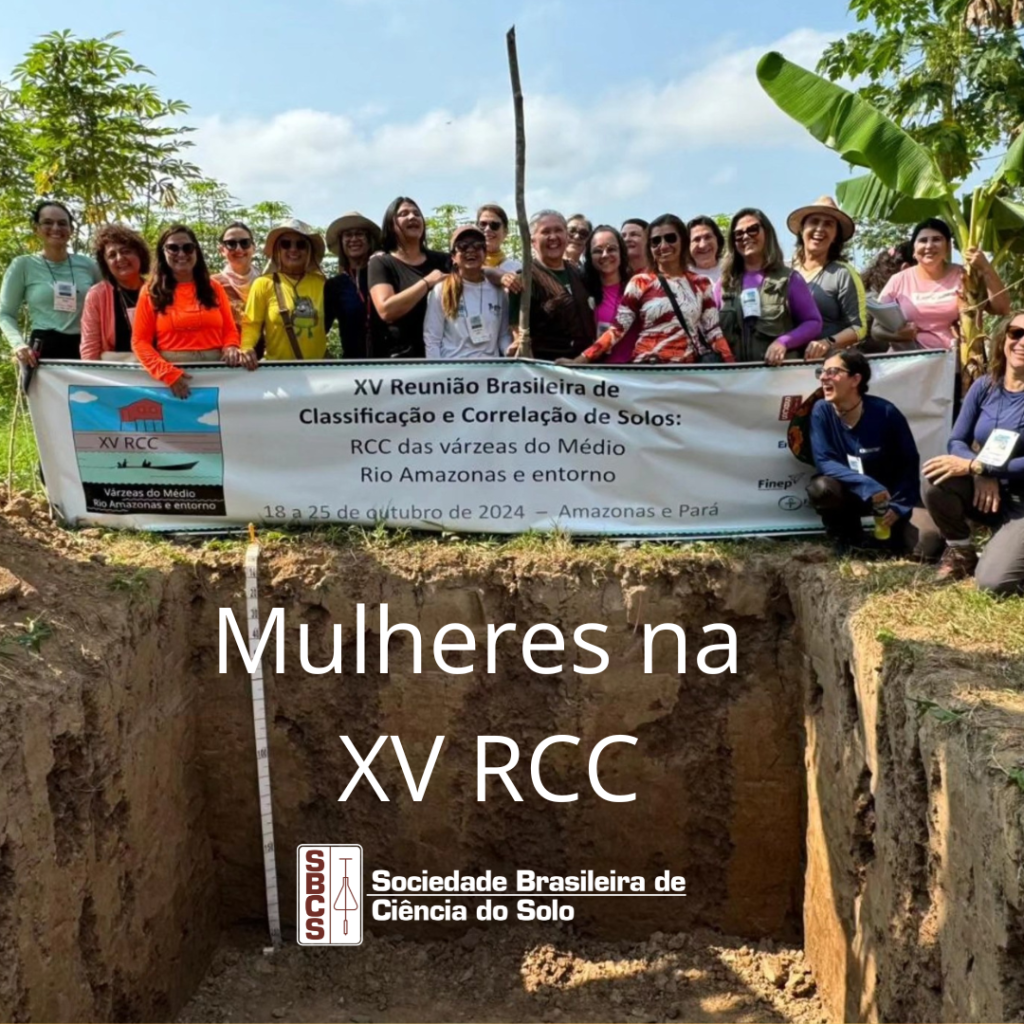
No início eram muito poucas. Com o tempo, as mulheres foram ganhando força e conquistando espaços também nas viagens para identificação de perfis nas Reuniões de Classificação e Correlação de Solos (RCCs).Neste ano de 2024, foram registradas 23 mulheres, quase todas nesta foto que ajuda a contar esta história de conquistas para as mulheres da ciência do solo. Porque, não custa lembrar: lugar de mulher é onde ela quiser. A XV Reunião de Classificação e Correlação de Solos (RCCs) ocorreu de 18 a 25 de outubro de 2024. Os participantes percorreram 1.400 km pelas amplas planícies aluvionares do Médio Rio Amazonas e regiões do entorno, sob vegetação de floresta amazônica, campinaranas e cerrado.
Potassium distribution in soil profiles under no-tillage system
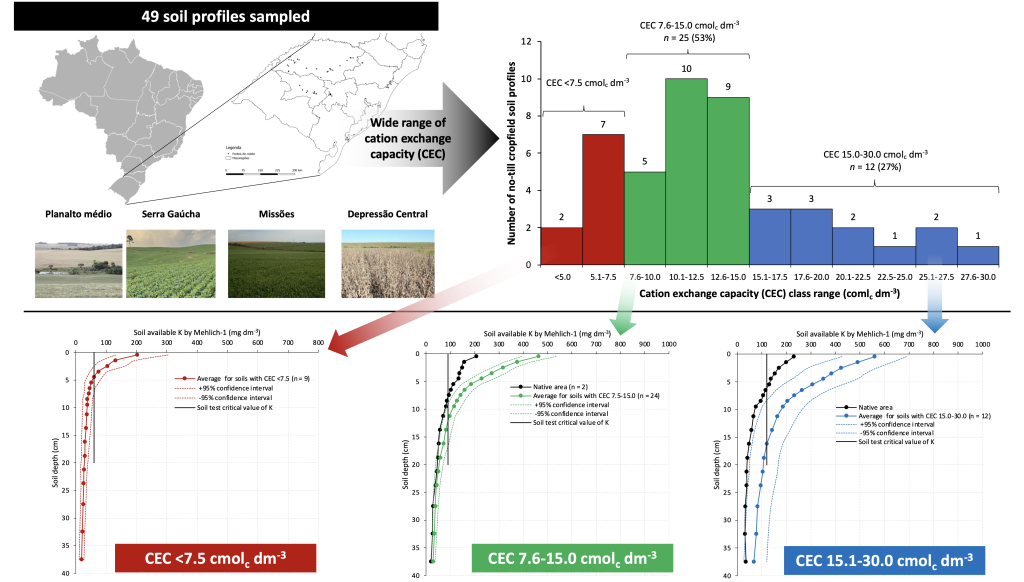
HIGHLIGHTS Study reveals K accumulation in upper soil layers under no-tillage systems. Findings emphasize deep K fertilization to prevent surface runoff and erosion. We suggest revising K availability diagnosis methods for no-tillage soil systems. Highlights limited K migration, urging precise fertilization near root growth zones. ABSTRACT Potassium (K) vertical mobility in soils has often been overestimated and used as a rationale for recommending the broadcast application of this nutrient in fertility management programs, especially in soils with low cation exchange capacity (CEC). This study aimed to evaluate the vertical distribution of K in two land uses: areas with natural vegetation and crop fields managed under no-tillage (NT) fertilized with K. For this purpose, 49 soil profiles from the Brazilian subtropical state of Rio Grande do Sul were sampled, comprising 45 profiles from areas under NT management and four profiles from sites with natural vegetation. Soil samples were collected in 19 very thin layers: 1 cm layer in the first 10 cm, 2.5 cm layer from 10 to 25 cm, and 5 cm layer from 25 to 40 cm. Sampling sites were then grouped according to their CEC, categorized as < 7.5, 7.6-15.0, and 15.1-30.0 cmolc dm-3. Both crop fields and natural fields exhibit a similar vertical gradient model, characterized by a strong accumulation of K in the soil within the uppermost centimeters. This gradient is notably enhanced by the addition of K fertilizers, leading to a substantial portion of K becoming inaccessible to the root system. The optimal level of available K for the topsoil soils was found within an average range of 4 to 12.5 cm of soil depth. Consequently, K fertilization resulted in two main outcomes: (i) an excess of K in the upper soil layers, which increases the potential for K loss through surface erosion and runoff, and (ii) a limited migration of K towards the deeper soil layers until reaching the root growth zone. There is an urgent need to: (a) reaffirm the official recommendations of public agencies that the replacement of K exported by crops should be carried out in the furrow, along the sowing line, and as deep as possible; and (b) reconsider the diagnostic soil layer for assessing the status of K availability in soils under NT management.
Chemical and mineralogical constitution of redoximorphic features and mechanism of formation of Plinthosols from the Araguaia River plain, Brazil
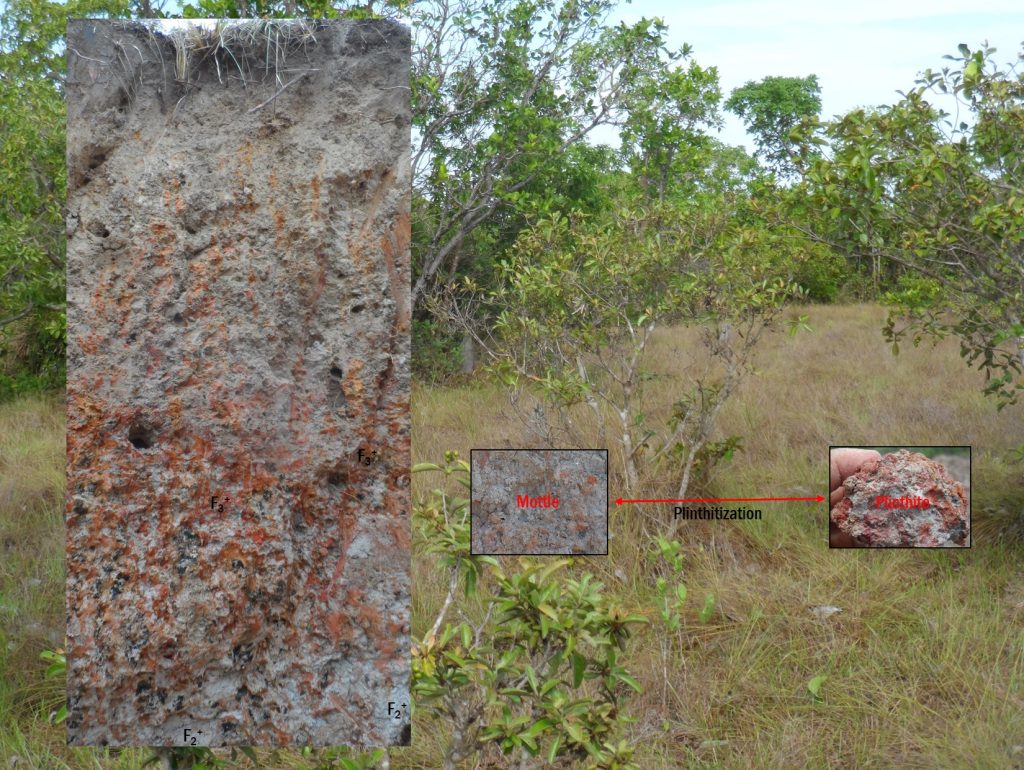
HIGHLIGHTS There are gaps in the knowledge of redoximorphic features in Plinthosols. Samples of the soil matrix, mottle, and plinthite features were analyzed. The total contents of silicon, aluminum, and iron accounted for 96% in all features. Higher iron contents occurred in plinthite, followed by mottle and matrix. Mottles and plinthite were not originated by the classical redox process. ABSTRACT Currently in Brazil, large grain cultivation projects on Plinthosols are a reality, however, there is little or no knowledge of the real mechanism of formation of the plinthite feature, in addition to what is reported in the literature as being a product of oxidation-reduction processes of iron element. This study evaluates iron redoximorphic features and investigates their chemical and mineralogical composition in two profiles of Plinthosols from the Araguaia River plain (P1 and P2). The study strengthens the understanding of the pedogenetic processes involved in the formation of mottles and plinthite. In this sense, it assesses whether the formation mechanisms corroborate the literature. Soil features were sampled in the upper right and left position at the initial plinthic horizon, upper right and left position at the main plinthic horizon, and lower right position at the base horizon of the plinthite zone in the profile. Separated samples comprising the soil matrix, mottles, and plinthite under natural moisture conditions were ground into powder form for chemical determinations by X-ray fluorescence (XRF), sulfuric acid attack (H2SO4), sodium dithionite-citrate-bicarbonate (DCB), and ammonium acid oxalate; and mineralogical determinations by X-ray diffraction. Iron contents in all determined forms were always higher in the plinthite feature, intermediate in the mottle feature, and lower in the soil matrix feature. Most of the Fe in all redoximorphic features is included in the structure of primary minerals and their derivatives (vermiculite, illite, and VHEs). Only part of the iron present (about 35.40 % in P1 and 41.98 % in P2) is detected in the form of oxides such as goethite and hematite, which could be formed in redox processes. The mottle and plinthite features under study are not the product of the classic process of segregation, mobilization, and accumulation of iron as a consequence of redox processes. These features were formed or emerged as a result of a relatively slow and constant weathering process of their source material, which is gradually decomposed in an aqueous medium, releasing most of its components. These components include iron and more mobile elements such as bases and silicon, which leave the system through drainage water, and of which a small part may eventually recombine to form new less complex minerals such as kaolinite and oxides.
Sediment source tracing in a Brazilian subtropical catchment using diffuse reflectance: Effect of spectral ranges, pre-processing techniques, and multivariate model
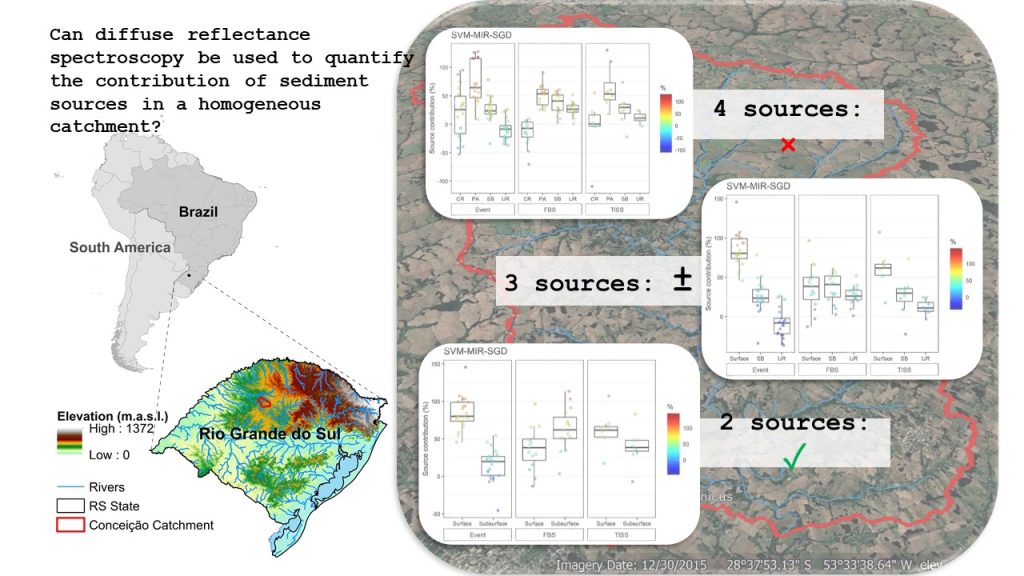
HIGHLIGHTS SVM outperforms PLSR for sediment source modeling, showing higher R² and lower RMSE. SGD pre-processing significantly improves SVM models, while PLSR benefits from SNV. UV-VIS spectra were less effective for source tracing compared to NIR and MIR. Reducing sediment sources enhances model reliability and decreases uncertainties. ABSTRACT Agriculture intensification in Southern Brazil’s subtropical regions combined with the frequent occurrence of erosive rainfall has rendered the area a global water erosion hotspot. In this scenario, understanding and regulating erosion processes at the river catchment scale is critical for mitigating soil and water resource degradation. Traditional methods for tracing sediment sources are expensive and time-consuming and justify the development of alternative approaches. Therefore, in this study, we employed diffuse reflectance spectroscopy analyses in the ultraviolet-visible (UV-VIS), near-infrared (NIR), and mid-infrared (MIR) ranges, combined with multivariate models and spectral pre-processing techniques to estimate sediment source contributions in a homogeneous subtropical catchment (Conceição River, 804 km²). Soil samples (n = 181) were collected to characterize the four potential sediment sources, including: cropland (n = 78), stream bank (n = 36), unpaved road (n = 40) and pasture (n = 27). Moreover, 44 sediment samples were collected, including suspended sediment (n = 8), fine sediment deposited on the riverbed (n = 15), and suspended sediment samples collected in the water column during storm events (n = 21). Vector machine (SVM) model outperformed the others, with better accuracy and reliability. While UV-VIS spectra proved less effective due to soil homogeneity across the catchment, NIR and MIR spectra provided valuable information for discriminating sediment sources. Furthermore, reducing the number of potential sources (from four to three or two) improved model predictions, especially when distinguishing between surface sources (cropland and pasture) and subsurface sources (unpaved roads and stream banks). The study’s findings shed light on the power of efficient and cost-effective alternative methods for assessing sediment sources, which are vital for promoting effective erosion control and sustainable land management in similar regions.




